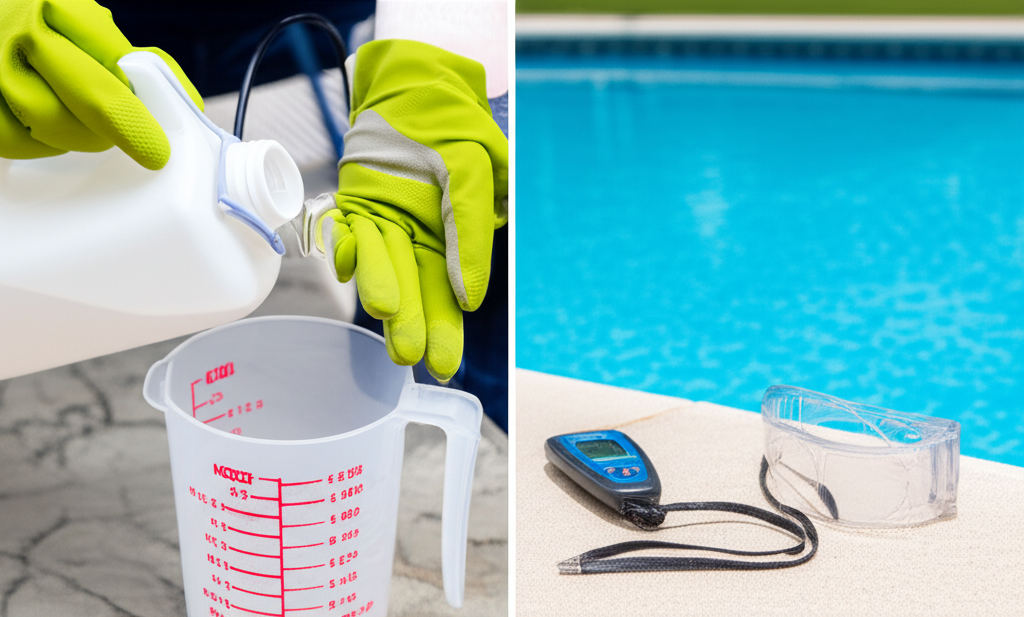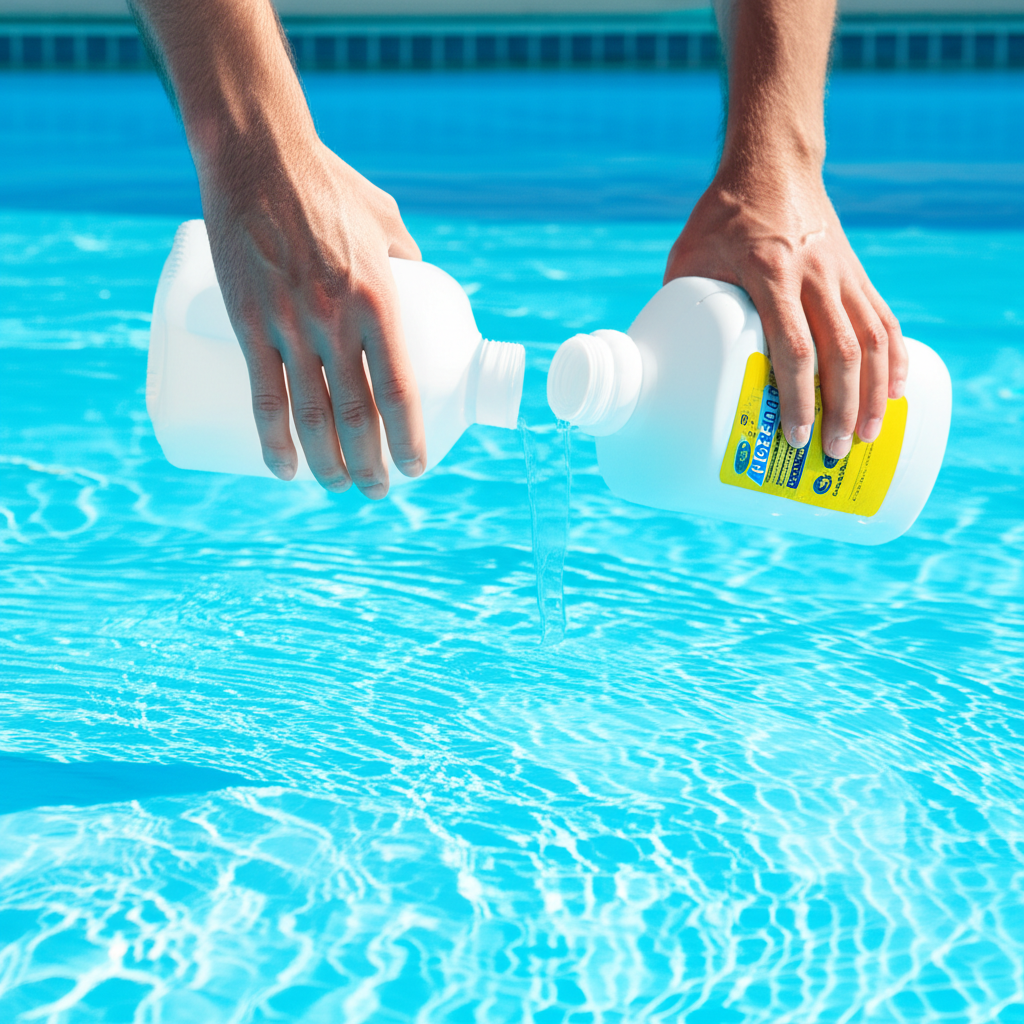- Why High Pool pH is a Problem
- Choosing Your pH Reducer: Muriatic Acid vs. Sodium Bisulfate
- Handling Muriatic Acid Safely
- Step-by-Step Guide to Lowering Pool pH
- Troubleshooting and Common Mistakes
- Maintaining Optimal Pool pH
Muriatic Acid is a powerful and effective solution for correcting high pH levels in swimming pools, but its potency demands careful handling and precise application. Maintaining an optimal pH balance is crucial for a healthy and enjoyable swimming environment. When your pool water’s pH creeps too high, it can lead to a host of problems, from swimmer discomfort to reduced sanitizer efficiency and even damage to pool equipment. This comprehensive guide will walk you through the process of safely and effectively using muriatic acid to bring your pool’s pH back into the ideal range.
Why High Pool pH is a Problem
Before diving into the solution, it’s important to understand why keeping your pool’s pH in check is so vital. The ideal pH range for swimming pools is between 7.4 and 7.6, though a range of 7.2 to 7.8 is generally considered acceptable. When pH rises above this, typically above 7.8, you might observe several adverse effects:
Reduced Sanitizer Effectiveness: Chlorine, the most common pool sanitizer, becomes significantly less effective at higher pH levels. This means you’ll need more chlorine to achieve the same sanitization power, leading to increased chemical costs and a greater risk of algae growth or bacterial contamination.
Cloudy Water: High pH often contributes to calcium scaling, causing the water to appear cloudy or hazy.
Scale Buildup: Elevated pH promotes the formation of mineral scales (primarily calcium carbonate) on pool surfaces, equipment, and even inside filter cartridges. This can lead to rough pool walls, clogged filters, and reduced efficiency of heaters and pumps.
Swimmer Discomfort: High pH can cause skin irritation, itchy eyes, and dry hair, making swimming less pleasant.
Shortened Equipment Lifespan: Scale buildup and compromised water balance can accelerate wear and tear on pumps, heaters, and other expensive pool components.
Choosing Your pH Reducer: Muriatic Acid vs. Sodium Bisulfate
When faced with high pool pH, your primary options for a pH reducer are typically muriatic acid (hydrochloric acid) or sodium bisulfate (dry acid). Both are effective, but they have distinct characteristics:
Muriatic Acid: This liquid acid is very potent and works quickly. It’s highly effective at reducing both pH and total alkalinity. However, it’s corrosive and requires strict safety precautions during handling and storage due to its fumes and liquid form.
Sodium Bisulfate (Dry Acid): Available in granular form, dry acid is generally safer to handle than muriatic acid as it produces fewer fumes and is less corrosive in its concentrated state. It still requires care, but its slower action and easier application make it a preferred choice for some homeowners. However, it can also add sulfates to the water, which can contribute to other issues over time if used excessively.
For pools requiring a significant pH drop or those needing to adjust both pH and alkalinity, muriatic acid is often the chosen solution due to its speed and efficiency.
Handling Muriatic Acid Safely
Because muriatic acid is a strong, corrosive chemical, safety must be your absolute top priority. Failure to follow safety guidelines can result in serious chemical burns, respiratory issues, or eye damage.
Essential Safety Equipment (PPE):
Goggles or Face Shield: Protect your eyes from splashes.
Chemical-Resistant Gloves: Neoprene or heavy-duty rubber gloves are ideal.
Long-Sleeved Shirt and Pants: Cover exposed skin.
Closed-Toe Shoes: Protect your feet.
Respirator (Optional but Recommended): Especially if working in a poorly ventilated area or if you are sensitive to fumes.
Safety Protocols:
1. Work in a Well-Ventilated Area: Always use muriatic acid outdoors, away from your face, and ensure good airflow to disperse fumes.
2. Add Acid to Water, Never Water to Acid: This is a critical rule for diluting any strong acid. Adding water to concentrated acid can cause a violent exothermic reaction, leading to splashing and dangerous fumes.
3. Prepare a Dilution Bucket: Always pre-dilute muriatic acid before adding it to the pool. Use a clean, dedicated plastic bucket (not metal) filled with at least 5 gallons of pool water.
4. Keep a Water Hose Nearby: In case of skin or eye contact, immediately flush the affected area with copious amounts of water for at least 15-20 minutes.
5. Store Properly: Store muriatic acid in a cool, dry, well-ventilated area, away from children, pets, pool chemicals (especially chlorine), and metals. Keep it in its original container with the cap securely fastened.
Step-by-Step Guide to Lowering Pool pH
Follow these steps carefully to adjust your pool’s pH using muriatic acid:
1. Test Your Pool Water: Use a reliable test kit or strips to measure your current pH level. Also, test your Total Alkalinity (TA), as muriatic acid will lower both.
2. Calculate the Required Dose: Refer to your pool chemical manufacturer’s dosing chart or a pool calculator app. These tools will tell you how much muriatic acid to add based on your pool’s volume and current pH level to reach the desired 7.4-7.6 range. It’s always best to add smaller doses and retest rather than overshooting.
3. Prepare for Application:
Ensure your pool pump is running to circulate the water.
Gather your safety gear (PPE).
Fill your dedicated plastic bucket with 5 gallons or more of pool water.
Have your calculated amount of muriatic acid measured and ready in a separate, non-reactive measuring cup.
4. Add Muriatic Acid to Water: Slowly and carefully pour the measured muriatic acid into the bucket of pool water. Stir gently with a plastic stirring stick. Remember, acid into water, never water into acid!
5. Distribute the Diluted Solution: Walk around the perimeter of the deep end of your pool (avoiding skimmer baskets and returns), slowly pouring the diluted acid mixture into the water. Never pour acid directly into the skimmer or near vinyl liners, as it can cause damage.
6. Allow for Circulation: Let your pool pump run for at least 2-4 hours to ensure the acid is thoroughly dispersed throughout the entire pool volume.
7. Re-Test Your Water: After the circulation period, re-test your pH. If the pH is still too high, repeat steps 2-6, but start with a smaller dose. It’s safer to make small adjustments over time than large ones all at once.
8. Monitor TA (Total Alkalinity): While lowering pH, you will also be lowering TA. If your TA drops too low (below 80 ppm), it can lead to pH instability (pH bounce). You may need to add a total alkalinity increaser (sodium bicarbonate) if this occurs after your pH is balanced.
Troubleshooting and Common Mistakes
pH Doesn’t Drop Enough: If your pH is still too high after the first application, wait at least 6-8 hours, retest, and then add another smaller dose. Be patient; sometimes it takes a couple of adjustments.
pH Drops Too Low: If you accidentally add too much muriatic acid and your pH falls below the ideal range (e.g., below 7.0), you’ll need to use a pH increaser (soda ash or sodium carbonate) to raise it. This is why incremental dosing is recommended.
Ignoring Safety: Never skip PPE or proper ventilation. The risks associated with muriatic acid are not worth the shortcut.
Adding Concentrated Acid Directly: Always dilute the acid in a bucket of pool water first. Pouring concentrated acid directly into the pool can cause localized damage, stains, or even corrode piping.
Maintaining Optimal Pool pH
Once you’ve achieved the ideal pH range, consistent maintenance is key to keeping it there.
Regular Testing: Test your pool water at least 2-3 times per week, especially during heavy use or after rain.
Balanced TA: Ensure your total alkalinity (TA) is in the 80-120 ppm range. TA acts as a buffer, helping to stabilize your pH.
Proper Sanitization: Keep your chlorine levels correct. Imbalanced chlorine can sometimes affect pH.
Alkalinity First: When making adjustments, it’s generally recommended to adjust alkalinity first, then pH, as TA acts as a buffer that influences pH stability.
Using muriatic acid can be a highly effective way to manage your pool’s pH, ensuring a clean, clear, and comfortable swimming experience. By understanding its properties, following stringent safety protocols, and applying it correctly, you can confidently maintain optimal water chemistry for your pool. Always prioritize safety, take your time, and test frequently for the best results.




